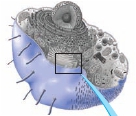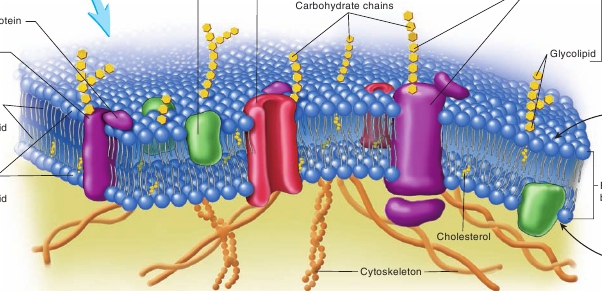CHAPTER 3 Cell Biology
63

Membrane channel
Integral protein
EXTRACELLULAR FLUID
Glycoprotein
Glycocalyx

Peripheralmembrane protein
Integralmembraneprotein
Nonpolar(hydrophobic)regionsof phospholipidmolecules
Polar(hydrophilic)regionsof phospholipidmolecules
Externalmembranesurface
Phospholipidbilayer
Internalmembranesurface
(a)
CYTOPLASM (intracellular fluid)
FIGURE 3.2
Plasma Membrane
(
a
) Fluid-mosaic model of the plasma mem-brane. The membrane is composed of abilayer of phospholipids and cholesterol withproteins “floating” in the membrane. The non-of each phospho-toward the center ofpolar, hydrophiliceither the extracel-cytoplasm. (
b
) Transmissionshowing the plasmacell. Proteins at eitherstain more readilyand give theappearance of having threeconsist of proteinsheads, and the centralphospholipid tails

(b)
3.4
Membrane Lipids
LEARNING OUTCOMES

After reading this section, you should be able to
A.
List and describe the functions of membrane lipids.
B.
Explain the nature of the fluid-mosaic model ofmembrane structure.
The predominant lipids of the plasma membrane are phospholipidsand cholesterol.
Phospholipids
readily assemble to form a
lipid
bilayer,
a double layer of phospholipid molecules, because theyhave a polar (charged) head and a nonpolar (uncharged) tail (seechapter 2). The polar heads are attracted to water molecules, so theyare also called
hydrophilic
(water-loving) heads. The polar, hydro-philic heads are exposed to the aqueous extracellular and intracel-lular fluids of the cell. The tails of the phospholipids are nonpolarand are not attracted to water molecules, so the tails are also called
hydrophobic
(water-fearing). The nonpolar, hydrophobic tails faceone another in the interior of the plasma membrane (figure 3.2). The
fluid-mosaic model
of the plasma membrane describes the plasmamembrane as being neither rigid nor static in structure. Instead, the